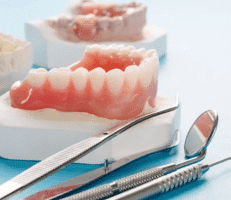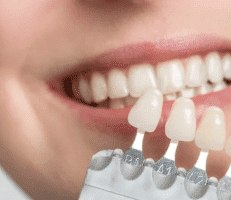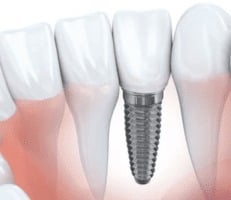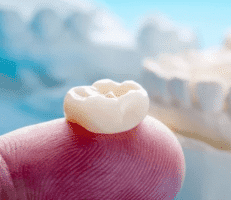Dental implants have earned an esteemed reputation in dentistry for their strength, stability, and durability. At Smile by Design Dental Group in Irvine, California, Michael Choi, DMD, and his team offer dental implant surgery, one of our premier services. We also offer custom crowns and All-on-4 or All-on-6 dentures for implant restoration. To see if you’re a good candidate for one or more dental implants, book a consultation online or over the phone today.
What Are Dental Implants?
Dental implants are titanium posts that hold dental prosthetics in your mouth permanently. The team at Smile by Design Dental Group performs a couple of simple surgeries to place the implants in your jaw, as well as the attachment pieces that latch onto them and hold your prosthetics (called abutments).

Before you get implants, the team takes X-rays and digital scans of your mouth. Using the X-rays, they evaluate the strength of your jawbone. Since the loss of the roots of your teeth can cause jawbone deterioration, you might need a bone graft to make your jawbone strong enough to hold an implant.
During the healing period after your first implant surgery — which varies from person to person but usually takes a few months — the bone in your jaw grows around the implant, making it sturdy. Once you’ve healed, the team at Smile by Design Dental Group reopens the incisions to attach the abutments.
What Are the Different Types of Dental Implant Restorations Available?
Dental implant restorations are the prosthetics that the dental team at Smile by Design Dental Group designs and mills to attach to your dental implants. Smile by Design Dental Group offers these two types of restorations:
Crowns
A single custom dental crown attaches to just one implant. The team makes your crown from ceramic material and attaches it to the implant abutment with a strong dental adhesive.
All-on-4 or All-on-6 Dentures
All-on-4 and All-on-6 dentures require just four or six dental implants, not one per tooth. They replace either the full upper or lower arch of teeth. If you have any remaining teeth in the arch, you’ll need them extracted before your implant surgery.
Benefits of Dental Implants
Dental implants offer a list of benefits that far outweigh some of the other options for replacing missing teeth, like removable dentures or dental bridges. If you opt for dental implants, you’ll enjoy these advantages:
- Stable teeth
- Great aesthetics
- Better phonetics
- Durable prosthetics
- The prevention of jawbone deterioration
- The prevention of teeth drifting into the vacant spaces
While the process of getting dental implants can be lengthy, the benefits make them worth the wait and planning. The team at Smile by Design Dental Group makes sure your new teeth look and feel completely natural after attaching them to your implant abutments.
Success Rates and Longevity of Dental Implants
Dental implants have around a 95% success rate – designed to last for life when properly cared for. The titanium posts fuse with the jawbone, creating a strong foundation for prosthetics that function like natural teeth. Regular follow-ups with Dr. Michael Choi ensure that your implants remain in excellent condition, contributing to their long-term durability and overall oral health.
Dental Implants vs. Other Tooth Replacement Options
Wondering if you should choose dental implants, dentures, or bridges to replace your teeth? Here’s how these three treatments compare:
- Dental Implants: Titanium posts are surgically placed into the jawbone, providing a permanent and stable foundation for prosthetics like crowns or dentures. Implants prevent jawbone deterioration and look and function like natural teeth.
- Dentures: Removable prosthetics that replace multiple missing teeth. While initially more affordable, dentures can be uncomfortable, slip, and require adhesives. They also do not prevent jawbone loss.
- Bridges: Fixed prosthetics that replace one or more missing teeth by anchoring to adjacent teeth. Although effective, they require the alteration of healthy teeth and do not address jawbone health.
Why Choose Smile by Design Dental Group?
Dr. Michael Choi, DMD, is a highly experienced dentist who has been performing dental implants since 1998. With over 20,000 implants successfully completed, Dr. Choi's expertise is unmatched. He is strongly committed to patient care, following up with patients even 10-15 years after their procedures. This dedication ensures long-term success and satisfaction for every patient.
Dr. Choi and his team are committed to using the latest technology to provide the best possible outcomes. This includes offering innovative one-day implants, such as All-on-4 and All-on-6 dentures, which provide quick and effective solutions for those needing extensive dental restorations. Choosing Smile by Design Dental Group means receiving top-tier dental care from a dentist who truly cares about your long-term oral health.
Dental Implants Q&A
How Long Does the Dental Implant Process Take From Start to Finish?
The dental implant process varies from person to person but generally spans several months. Initially, we’ll take X-rays and digital scans to assess the jawbone’s strength. If needed, we may perform a bone graft to prepare the jawbone.
After the initial implant surgery, you’ll heal for a few months while bone grows around the implant. Once that has healed, you’ll have a second minor surgery to attach the abutments. The final step involves placing the custom-designed prosthetics to complete the process.
What Should I Expect During the Recovery Period After Dental Implant Surgery?
During the recovery period after dental implant surgery, you can expect some swelling, bruising, and minor discomfort around the implant site, which typically subsides within a few days. You can manage pain with over-the-counter pain relievers. Follow Dr. Choi’s post-operative care instructions, which include maintaining good oral hygiene and avoiding hard or sticky foods. The healing period, during which the jawbone integrates with the implant, usually lasts a few months. Regular follow-up visits ensure proper healing and implant stability.
Are Dental Implants Suitable for Everyone?
While dental implants are a versatile solution for many, they may not be suitable for everyone. Ideal candidates should have sufficient jawbone density to support the implants and have good overall health. Conditions like uncontrolled diabetes, smoking, or certain medications can affect healing and implant success. Additionally, patients must commit to maintaining excellent oral hygiene and regular dental visits. A thorough evaluation at Smile by Design Dental Group will determine if dental implants are the right option for you.
What Financing Options Are Available for My Dental Implants?
The cost of dental implants at Smile by Design Dental Group can vary based on the type and complexity of the restoration. To make the process more affordable, the clinic offers several financing options.
- Cherry Financing allows you to split costs into manageable monthly payments with flexible terms and quick approval processes.
- Proceed Finance offers long-term loans with competitive rates and no hidden fees, making life-changing treatments accessible. Pre-qualify without affecting your credit score.
Smile by Design Dental Group is committed to making this process as accessible and manageable as possible.
Schedule Your Dental Implant Consultation Today
To learn more about the dental implant process for All-on-4, All-on-6, or singular implants, schedule an online appointment or call 949-786-2820. Smile by Design is ready to help restore your smile in Irvine, California!













 Don’t miss this opportunity—click the link to learn more and get started today!
Don’t miss this opportunity—click the link to learn more and get started today!